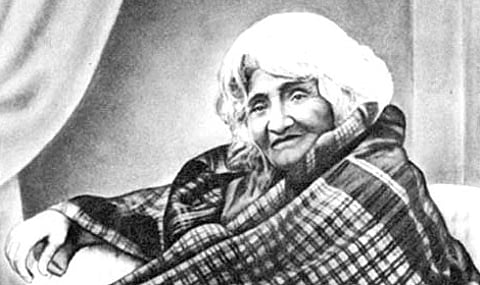Hazrat Babajan, The Great Seer Of Pune
The Vedic Rishis communed with Nature and had taught a religion that had become universal in character and outlook. Later on, elaborate rituals and ceremonials were introduced. The Lord Buddha revolted against these forms and formalities and pleaded for a religion of Truth and freedom from exploitation of any kind.
Our impact with Western culture had led to certain far-reaching changes alike in our society and in our religious outlook. The Arya Samaj and the Brahma Samaj have been the products of such impact. But substantial contribution towards spiritual thought has been made by Bhagwan Sri Ramakrishna Paramahansa, who had, after observing the practices of the major religions of the world, discovered certain essential unities to be underlying them and then preached universal brotherhood.
It was about this time that Madame Blavatsky had founded the Theosophical Society, which had, apart from aiming at a rational and scientific interpretation of Religion, sought to reveal to a sceptic world the existence of the occult region. Madame Blavatsky had to resort to abnormal phenomena for this purpose in the same way as Bhagwan Sri Ramakrishna Paramahansa had done on some occasions.
Hazrat Babajan had also similarly shown in her life and activities the existence of the occult world and demonstrated that in spirituality there was no room for distinctions of caste or community or even sex, or for mystifying fundamental principles. She had also performed miracles purely in the service of humanity. An account of her life is, therefore, bound to be of inspiration to earnest spiritual aspirants.
Hailing from Afghanistan or Baluchistan, Hazrat Baba Jan was the daughter of one of the ministers of the Amir of Afghanistan. The year of her birth is said to be 1790 and, as her birthday was observed once on 28th January, we might take it that she was born on the 28th January, 1790. Gul-rukh was her name and she was brought up as an Afghan aristocrat and had learnt the Koran at a very early age. Gul-rukh spent her youth in prayer, meditation, seclusion and in a manner that was altogether unusual to her surroundings.
Blessed with surpassing beauty and charm, when she was only fifteen, she was sought for in marriage to which her parents had gladly acceded. She managed to escape on the day fixed for her wedding through Peshawar to Rawalpindi where she was initiated by a Hindu Saint. The initiation was followed by severe austerities for seventeen months on a mountain in the vicinity. At thirty seven, she obtained 'Realisation' by the grace of a Muslim Saint at Multan.
After visiting many places in northern India, she settled down in 1903 in the shade of a neem (margosa) tree in Char Bavadi, a place in Malcolm Road in Poona. She became universally known as HAZRAT BABA JAN. Bent with years and shabbily dressed in long apron, pyjama and a linen scarf, with a mass of unkempt snowy hair reaching down her shoulders and moving about restlessly, smoking "beedis", she still retained the blue of her eyes and a magnetic charm. Tea-stall vendors and fruiterers welcomed her to their establishments and let her help herself as she liked, for her visits were followed by phenomenal prosperity in their trade.
The place where she lived—a neglected spot full of squalor and haunted by riff-raffs was quickly transformed into a centre of pilgrimage with scent of incense, sound of music and presence of her devotees. But she remained perfectly unconcerned. Irregular and scanty food and frequent tea-drinking failed to affect her health. In 1903, she left for Mecca on a pilgrimage and when the vessel in which she was sailing was caught in a sea-storm; she bade one of the passengers beg pice from the rest with which to propitiate Allah by feeding the poor near the Kaaba; the ship was saved. She diagnosed all diseases as due to bad Karma and cured the patients.
She used to mutter "Vermin’s are worrying me always. I sweep them off, but again they swarm around me." She was as much a benefactor of those that wanted material well-being as of the spiritually enlightened. Referring to Baba Tajuddin, she used to observe that Tajuddin gave unto others only what she had herself granted him.
Of the innumerable miracles performed by her, to cite only a few: On account of her challenging statements she was once buried alive at Rawalpindi, by the very persons. Who later on found her very much alive and active at Poona. Remaining where she was, she once saved people from an accident of fire which had broken out in an opera, twenty miles off Poona. She helped a man find his missing horse. She cured fevers, restored sight and saved people from all kinds of dangers.
She rejected gifts of cash or of any kind offered in gratitude. Her greatest gift to the Universe is her initiation of Meherwan to become Avatar Meher Baba about whom details will be furnished later. She used to call herself God and a source of all creation and advised people always to aspire to what concerned the spirit which alone had remained eternal.
On the 21st September, 1931, Hazrat Baba Jan left her body. After a grand funeral, her remains were interred in a tomb at the very spot where she had lived. Her tomb has
Become a shrine attracting numerous pilgrims throughout the year.
Hazrat Baba Jan had come from the mountainous regions in the northern boundary of our holy land to the plains of Hindustan as a messenger of hope and spiritual regeneration of humanity.

